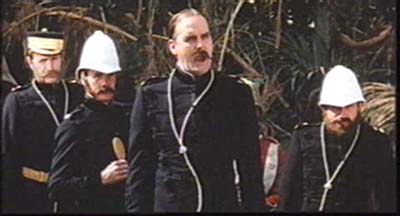A step up from the Gatling Gun (see here), which fired small arms ammunition, this Hotchkiss Revolving Cannon fired 37mm projectiles from its 5 barrels. This version is mounted for field work, but it was frequently used on naval platforms, especially lighter craft and gunboats. With the gun shield discarded, it could also be packed onto two mules.
 |
| Manufactured in France, 1880 |
 |
| Detail of the business end |
Here is an example of a Naval Deck mounting (not my pic)
The Hotchkiss also came in larger calibre - 40, 47 and 53mm with increasing weight and reduced portability.
It was developed by an American, Benjamin Berkeley Hotchkiss, living in France. He was approached by French officers looking for a fast firing gun, and it was soon adopted by all the major Powers, including the U.S., which went for it in a big way.
The mechanism differed from the Gatling Gun in that there were multiple barrels but only one striker, bolt and extractor. A center cam wheel is turned by the hand crank, which both rotates the barrels and holds them in place during different phases. Each rotation of the crank loads one shell, fires one shell and extracts one shell. The cam gear is cleverly shaped to turn another gear in the left side of the breech block which is pinned to 2 toothed shafts. The upper toothed shaft strips off a shell from the magazine and loads it in the chamber, while the bottom toothed shaft extracts a shell and dumps it out the bottom. The firing pin strikes the shell when the barrel is at the bottom of it's rotation.
The ammunition for the gun is a self contained cartridge, made up of brass wrapped into a cylinder with a solid center primed head, as in early British rifle bullets. An explosive shell and a canister shell were available, Canister consisted of steel shot, not unlike a giant shotgun shell, and was murderous against groups of the enemy. The shells weighed around a pound, were 5 inches long, and the tin or zinc magazine held 10. To unload the gun after firing consisted of removing the firing pin, rotating the barrels backwards with the handcrank and prying out the shells with a screwdriver, or pushing them out with a ramrod. Standing downstream from the gun had to give the gunner a moment of pause, as with unloading the Gatlings.
Some Hotchkiss guns were mounted on British ships, although they really preferred the Nordenfelt gun. Some guns were used in the Boer War, and at least one was present at the seige of Mafeking.






3 comments:
Ah yes the weapon that got me into VSF.
Now if that is not real life VSF nothing is...
A piece of equipment that is beauty to behold!
I think HLBS makes this in 28mm.
Thanks for your pictures I've not seen one with the shield before.
Nice piece of hardware, I can only imagine what it must have been like ducking for cover as bullets twanged against that metal guard. Those were the days!
Post a Comment